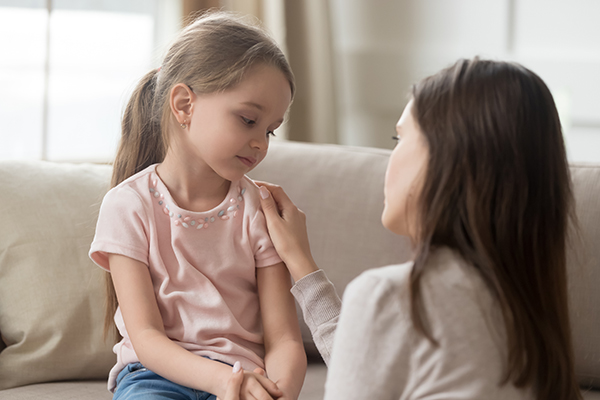I’m reasonably sure if I asked most parents if they want to learn how to deepen their connection with their child, they would say “Yes!” The answer is reflective listening. It’s something that may feel hard at the start, but after some practice it gets easier.
Reflective listening can help deepen your bond with your child. It can also help you to get your child to open up and talk about what is going on for them. It’s a life long skill that you can use with them right through to their adult years that will help you both feel deeply connected. In fact, you can use it with anyone! It’s one of the key skills that therapists use in counselling.
Reflective listening can help your child
- Feel deeply understood and accepted by you
- Open up and talk about their problems
- Strengthen their bond with you, and deepen their love for you
- To improve their emotional intelligence
- To develop a well-rounded and healthy sense of self
- Accept themselves as they are, without the punitive self-judgements many of us are plagued by.
There are two types of reflective listening.
Reflecting what your child says
Reflecting what your child says is a way of saying back to them what you have heard them say. When you do this, it lets your child know that you have really ‘heard’ what they have said, which in turn helps them feel deeply understood and accepted by you. Then, they are also then more likely to open up and talk to you more about what is bothering them.
Reflecting your child’s feelings
Reflecting your child’s feelings is similar to reflecting what your child says, but this time you add in an emotional component. When your child expresses their feelings, and the parent then accepts those feelings with empathy and understanding, the feelings will decrease in intensity and lose their sharp edges. Your understanding serves as emotional first aid for bruised feelings. It can also help calm conflicts (keeping them inside their window of tolerance) as your child won’t have to keep pushing with negative behaviour when they don’t feel understood. You can read more about reflecting feelings here.
Guidelines for reflecting what your child says
- Concentrate on your child
- Give them eye contact
- Listen to your child and the summarise what you’ve heard them say.
For example
Child “Today at school, we wrote stories about where we want to go on holidays.”
Parent “Oh, you wrote a story about going on a holiday?”
Child “Yeah, I pretended we’re going to space!”
Parent “Oh! You wrote about going to space!”
Child “Yeah, and they had slime waterslides and there were aliens everywhere.”
Parent “Slime waterslides and lots of aliens!”
That was a simple example, but you can see how it has the potential to help kids to open up more. If the child said “Today at school, we wrote stories about where we want to go on holidays” and the parent just said “oh really?” it is unlikely the conversation would go too much further. Imagine how this could help a child open up if there was something bothering them. Read on!
Here is one where reflecting what your child says is combined with reflection of feelings. This example is helpful when your child is sad or something is bothering them. It will help them open up and talk to you more.
Parent “You seem sad this afternoon.”
Child “Yeah, a bit.”
Parent “That’s no good. Something must have happened at school.”
Child “I got in trouble off Mrs Holt again.”
Parent “And that’s making you really sad.”
Child “Max stole my pencil so I told him to give it back. Then Mrs Holt yelled at me for being loud and I had to sit inside at recess. Max didn’t even get in trouble and he started it!”
Parent “You’re mad that you got in trouble and Max didn’t even though he was part of what happened.”
Child “Yes, it’s not fair! She always picks on me!”
Parent “You’re mad because it feels like Mrs Holt blames you all the time even when it’s not your fault.”
Points to remember
- Try to avoid the temptation to make your child’s feelings go away. For example, “That’s nothing to be upset about” or “If you don’t stop crying we’re not going anywhere”. These responses won;t make the feelings go away, but they will make your child feel like you don;t understand. It won’t help them feel better. Alternatively, if you reflect what they say and their feelings, it can help the hurt get smaller.
- Try to avoid the temptation to make your child feel ok. For example, “It’s ok, I’ll buy you a new one” or “You do have friends though, you have your brother, and dad and I”. Again, this will send a message to your child that you don;t understand. It’s very unlikely that your responses will help them in any way.
- When you understand how your child feels and let them know that you understand, you make room for their feelings and allow them to go deeper into them if they want to.
- Try to avoid asking questions. Usually, if you have enough information to ask a question, you have enough information to make a statement. For example, instead of “Did that make you angry?” (which can imply lack of understanding), say “That made you angry”. If you get it wrong, trust your child to correct you.
- Empathic statements go into the child’s heart and soul; questions go to the mind to be processed and evaluated.
It can be a tricky skill to master, but once you have you’ll see nothing but benefits! If you would like to read some more on these techniques, this little book is a gem. Say What You See is inexpensive, a quick read, but will help you master the technique in no time.

